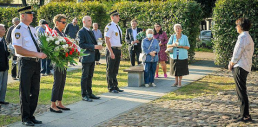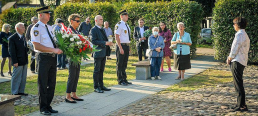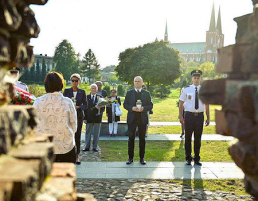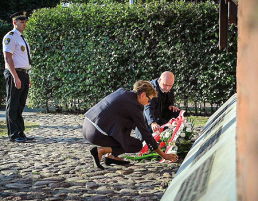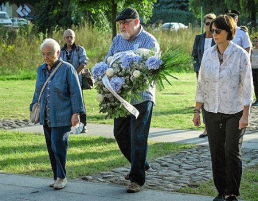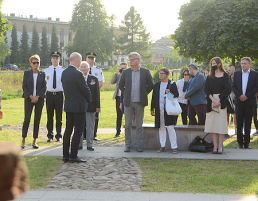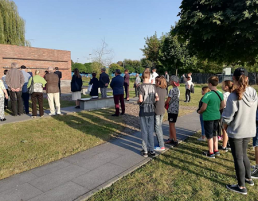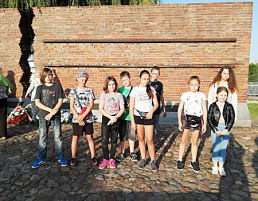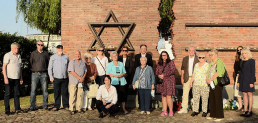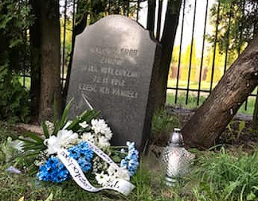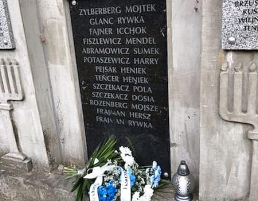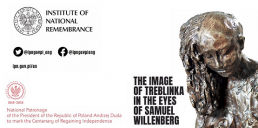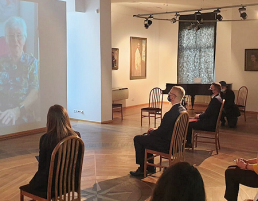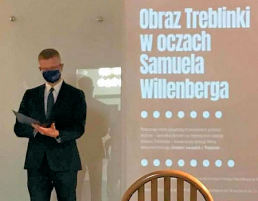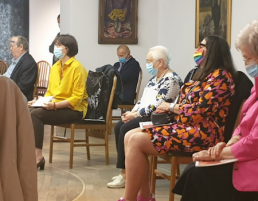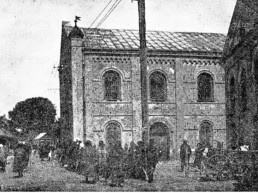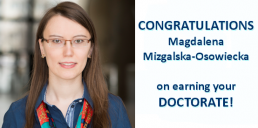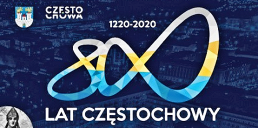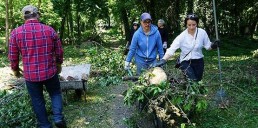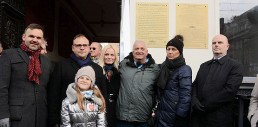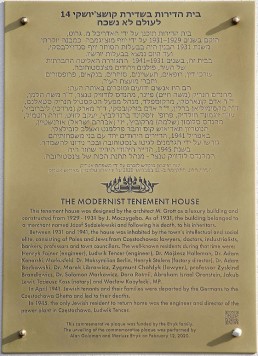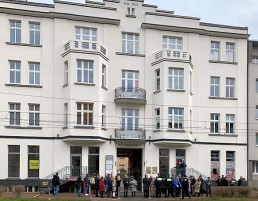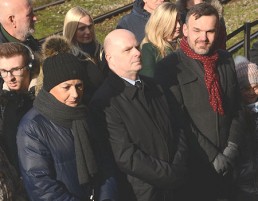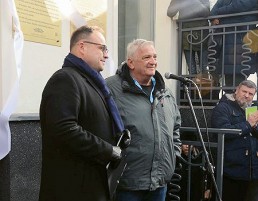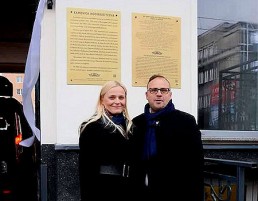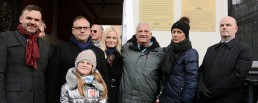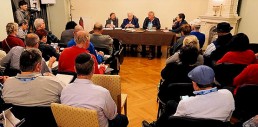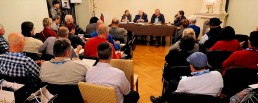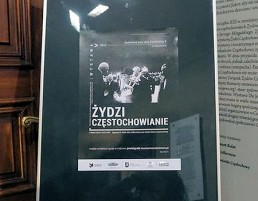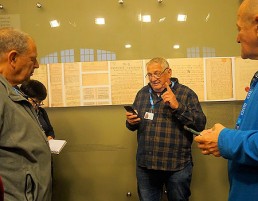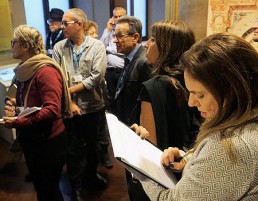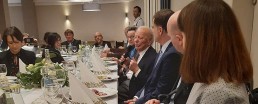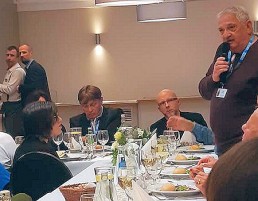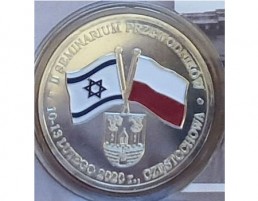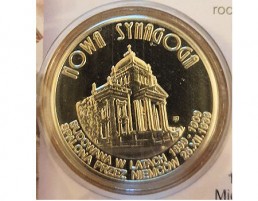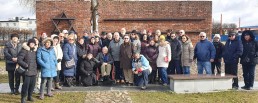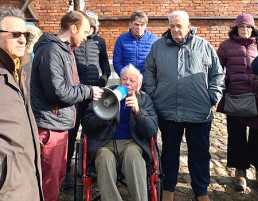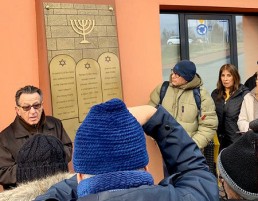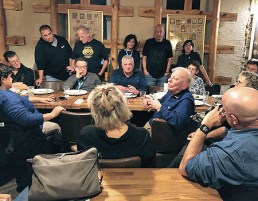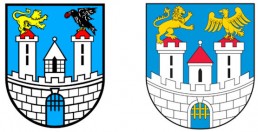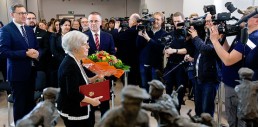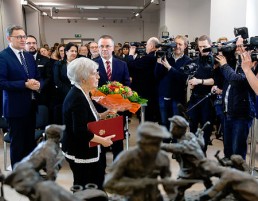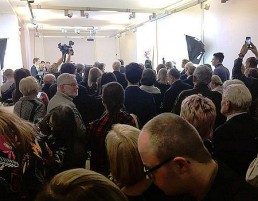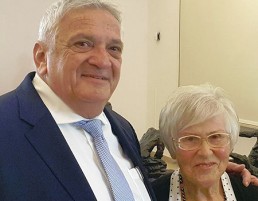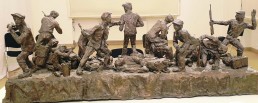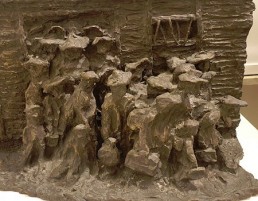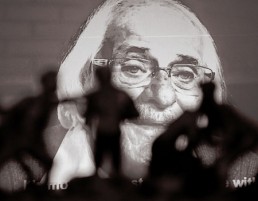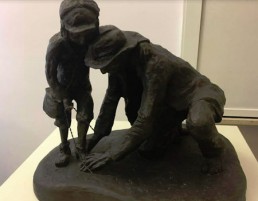Częstochowa Commemorates 78th Anniversary of Ghetto Liquidation
Latest News
Sources: Alon Goldman, Jolanta Urbańska and Gazeta Wyborcza
Organised by Izabela Sobańska-Klekowska, Chair of the Częstochowa branch of the TSKŻ (Social-Cultural Association of Jews in Poland), a ceremony was held at the memorial to Częstochowa Jewish Holocaust victims commemorating the 78th anniversary of the liquidation of the Czestochowa ghetto.
The liquidation of the ghetto lasted two weeks, between 22nd September and 7th October 1942, during which six train transports of cattle cars departed from the train station on ul. Strażacka headed for Treblinka.
Held in the presence of Częstochowa Deputy Mayor Dr. Ryszard Stefaniak, Deputy Chair of the City Council Jolanta Urbanska , members of the small Jewish community and guests, the ceremony was also attended by high school students, friends and youth from the Adulam Foundation (Fundacja Chrześcijańska Adullam), who assist in the cleaning up of the Częstochowa Jewish cemetery.
Willenberg's Treblinka Exhibition Opens in Częstochowa
Latest News
Source: Alon Goldman
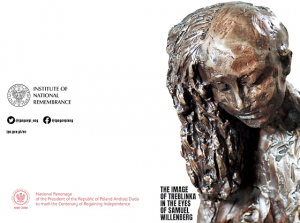 An exhibition of bronze Treblinka sculptures, by our late landsmann Samuel Willenberg z”l, opened in Częstochowa on Thurday 17th September 2020. The Official Opening of the exhibition, entitled “The Image of Treblinka in the Eyes of Samuel Willenberg”, took place at the Częstochowa Municipal Museum, in the presence of the Mayor of Częstochowa, Krzysztof Matyjaszczyk.
An exhibition of bronze Treblinka sculptures, by our late landsmann Samuel Willenberg z”l, opened in Częstochowa on Thurday 17th September 2020. The Official Opening of the exhibition, entitled “The Image of Treblinka in the Eyes of Samuel Willenberg”, took place at the Częstochowa Municipal Museum, in the presence of the Mayor of Częstochowa, Krzysztof Matyjaszczyk.
In collaboration with the Institute of National Remembrance, which brought the exhibition from Israel to Poland, and at the request of Alon Goldman, the exhibition was intended to be part of the World Society’s Sixth Reunion, which was scheduled to be held in early October, in conjunction with the Huberman Festival in the Częstochowa Philharmonic. However, due to the COVID-19 pandemic, plans for our next Reunion have been deferred until 2021.
The date of the exhibition going on display in Czestochowa is not random, as between 22nd September and 7th October 1942, about 40,000 Czestochowa Jews were deported to their deaths in the German death camp in Treblinka – in six transports of cattle trains.
Samuel Willenberg was lucky. When he arrived in Treblinka from the Opatów ghetto where he was staying, as he got off the train in Treblinka, he met his teacher from Czestochowa who told him, “If they ask, say you are a builder”. And so it was – of all the 6,000 Jews who had arrived on this transport, he was the only one to remain alive and was sent to a work group.
The exhibition presents figures and events that were etched into Samuel Willenberg’s memory during the ten months which he spent in the death camp until his escape on 2nd August 1943, during the rebellion which took place in the camp.
“The Image of Treblinka in the Eyes of Samuel Willenberg” exhibition will remain on display on the city’s main boulevard
at the Galeria Dobrej Sztuki al. NMP 47 until mid-October.
A replica of the sculpture exhibition can be viewed in Israel at the “House of Remembrance for the Holocaust and Heroism of Ariel”, a house built by Holocaust survivors Yaakov (Kuba) Wodislawski z”l from Czestochowa and his wife Irina.
The website is http://memorial.ariel.muni.il/. The Museum address is: Derech Hanachshonim 14 Ariel, tel: 03-9060105.
Admission to the museum and tour is free, but please arrange your visit in advance.
Żarki Yizkor Book to be Translated into English for the First Time!
Latest News
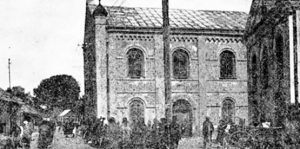 Żarki is a town lying about 35 kms from Częstochowa. The history of the town goes back to the 12th century, with Jews first settling there in the 16th century. At the outbreak of the Second World War, the town’s population reached around 5,000, of whom 60% were Jews. When the War ended, the Jewish community of Żarki was no more.
Żarki is a town lying about 35 kms from Częstochowa. The history of the town goes back to the 12th century, with Jews first settling there in the 16th century. At the outbreak of the Second World War, the town’s population reached around 5,000, of whom 60% were Jews. When the War ended, the Jewish community of Żarki was no more.
In 1959, in Israel, Holocaust Survivors from Żarki published a Yizkor Book entitled “The Community of Żarki – a Town in its Life and its Destruction”.
As far as we are aware, this is the only Yizkor Book ever published about the Jews of Żarki. Written predominantly in Hebrew, apart from its “Table of Contents” and its “Necrology” section, it has never been translated into English – UNTIL NOW!
It has therefore been decided that this will be the next Yizkor Book to be professionally and entirely translated into English, as part of our YIZKOR BOOK PROJECT. Translations will begin to appear on our website soon!
Congratulations Dr Magdalena Mizgalska-Osowiecka!
Latest News
Source: Andrew Rajcher
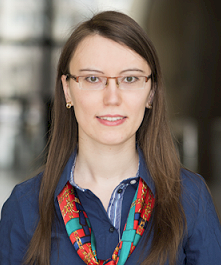 It is with immense pleasure we announce that, last week, Magdalena successfully defended her doctoral thesis and is now Dr Mizgalska-Osowiecka! Our pride in Magda’s achievement comes second only to the pride that her parents, Jerzy and Krystyna Mizgalski, must be feeling. The Mizgalski family are long-time friends of our World Society and, in gaining her doctorate, Magda is now following in the footsteps of her historian father, Professor Dr hab Jerzy Mizgalski, whose area of specialisation is the history of Częstochowa Jewry. Jerzy is also the creator and curator of our exhibition in the Częstochowa Jewish Museum.
It is with immense pleasure we announce that, last week, Magdalena successfully defended her doctoral thesis and is now Dr Mizgalska-Osowiecka! Our pride in Magda’s achievement comes second only to the pride that her parents, Jerzy and Krystyna Mizgalski, must be feeling. The Mizgalski family are long-time friends of our World Society and, in gaining her doctorate, Magda is now following in the footsteps of her historian father, Professor Dr hab Jerzy Mizgalski, whose area of specialisation is the history of Częstochowa Jewry. Jerzy is also the creator and curator of our exhibition in the Częstochowa Jewish Museum.
Those of you who have attended all of our World Society Reunions will have got to know Magda and seen her develop, over the years, from a high school teenager into a respected history academic. Today, Magda heads the Historical Information Unit of the Digital Collections and Resource Centre at the POLIN Museum of the History of Polish Jews. She has already authored and co-authored numerous articles and has regularly delivered papers at academic conferences.
Her first major academic achievement came when she was still in high school. In 2006, Magda won a Poland-wide competition on the “History and Culture of Polish Jews”. Her entry, about the history of the Jewish community in Częstochowa, won her a guaranteed place at the Warsaw University. That contest was sponsored by the Polish Ministry of National Education and Sport, Warsaw University’s Institute of History, the Institute of National Remembrance and the Israeli Ministry of Education.
Magda’s academic achievements then continued. At Warsaw University’s Institute of History, Magda gained her Bachelor of Arts degree (in 2010) with a thesis on “The Participation of Jews in Local Government in Częstochowa (1927 – 1939)” and her Master of Arts degree (in 2012) with a thesis on “The Issue of Former Austrian Officials and Officers in Eastern Galicia During 1918-1923”. After gaining her Masters degree, she completed a year of post-graduate study, at the University of Southampton, specialising in Jewish history and culture.
In 2017, her Bachelor’s degree thesis was published in book form.
In 2013, Magda began studying for her doctorate at the Tadeusz Manteuffel Institute of History at the Polish Academy of Science in the Department of History of Totalitarian Systems and World War II. The topic of her doctoral thesis was “British Policy on Jewish Emigration During the Evian Conference in 1938”:
The dissertation presents the position of Great Britain during the international conference in Evian in July 1938. Former British dominions, including Australia and Canada, as well as other British dependent areas, including Palestine are also included. United Kingdom legislation, regulating the entry of foreigners, and international legislation, regulating the refugee problem before July 1938, are both discussed. The international situation before the conference and the course of the conference itself, as well as its participants, the work schedule and the final resolution, are characterised. The positions of selected charity organizations, participating in the meeting and their impact on the conference, are also presented. The work includes a critical evaluation of the state of research on the discussed topic. When assessing the Evian conference in retrospect, attention is drawn to its importance in the international discussion on refugees and the British contribution to this discussion.
Last week, Magda successfully defended her thesis, thereby earning her PhD.
Magda, from everyone at the World Society, we say “Congratulations! Gratulacje! Mazel Tov!”.
Częstochowa's 800 Year History
Latest News
Sources: The Mayor of Częstochowa, Krzysztof Matyjaszczyk
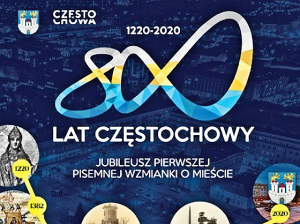 While the first mention of Jews in Częstochowa dates back to 1620, the existence of the city itself goes back 400 years earlier – to 1220 – when, on 25th December 1220, in Krakow, Iwo Odrowąż, Bishop of Kraków and Chancellor to Prince Leszek the White, issued a document for the monastery of the Canons Regular in Mstów, listing surrounding settlements which were obliged to pay tithes to the monastery. One of the villages mentioned was Częstochowa.
While the first mention of Jews in Częstochowa dates back to 1620, the existence of the city itself goes back 400 years earlier – to 1220 – when, on 25th December 1220, in Krakow, Iwo Odrowąż, Bishop of Kraków and Chancellor to Prince Leszek the White, issued a document for the monastery of the Canons Regular in Mstów, listing surrounding settlements which were obliged to pay tithes to the monastery. One of the villages mentioned was Częstochowa.
To mark this anniversary, the City of Częstochowa has created a magnificent website, with a timeline, telling the history of the city from its first mention in 1220 to the present day in 2020.
The website’s presentation of the 800 years of the city’s history is amazing – both in graphics and text.
Unfortunately, the text is only in Polish, but it is certainly worthwhile to use a translator, such as Google Translate, to learn much about our families’ home city’s history.
At a press conference held on Thursday 6th February, Częstochowa Mayor Krzysztof Matyjaszczyk promised that “there will be many surprises” as part of the anniversary celebrations – this is certainly one of them.
To view the website, go to http://www.800.czestochowa.pl/.
Częstochowa Jewish Cemetery Clean-Up Postponed
Latest News
Source: Alon Goldman
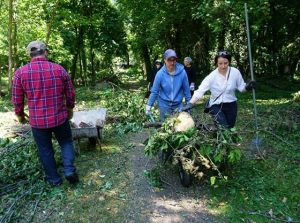 World Society Vice-President, Alon Goldman, has announced that, regretably, this year’s annual clean-up of the Częstochowa Jewish Cemetery, due to take place 1st-5th June 2020, has had to be postponed due to the COVID-19 pandemic.
World Society Vice-President, Alon Goldman, has announced that, regretably, this year’s annual clean-up of the Częstochowa Jewish Cemetery, due to take place 1st-5th June 2020, has had to be postponed due to the COVID-19 pandemic.
“We were full of hope to be able to carry out the project in the allotted time but, as the target date approached, we saw that we simply could not go forward”, he said. “Airline flight schedules have not returned to normal and the need to quarantine everyone who enters Poland, together with the health and security concerns for our partners in Poland, have brought us to a tough decision”.
He added that “we are now checking out possibilities for re-scheduling the clean-up and, when we have done so, we will make another announcement. As you no doubt know, if we do not carry this project out, no one else will do it! We are certainly not giving up and, as soon as the situation allows, we will definitely return to continue our work”.
In making the announcement, Alon thanked all friends and partners for their commitment and assistance – the USA Matzevah Foundation, the Częstochowa Adullam Foundation, the participating high schools from Czestochowa and Israel and all of the wonderful volunteers.
Pre-War Residents of Częstochowa Building Remembered
Latest News
Words and pictures: Alon Goldman
Back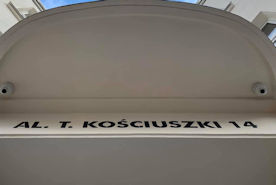 in May 2019, we published the story of the building at Aleja Tadeusza Kościuszki 14, a building inherited by Mariusz Etryk. Before the War, some 80% of its residents were Jews. While Mariusz had some surnames of the former residents, he contacted World Society Vice-President, Alon Goldman and, we published an appeal for more information about those residents.
in May 2019, we published the story of the building at Aleja Tadeusza Kościuszki 14, a building inherited by Mariusz Etryk. Before the War, some 80% of its residents were Jews. While Mariusz had some surnames of the former residents, he contacted World Society Vice-President, Alon Goldman and, we published an appeal for more information about those residents.
With the list he already had and with the help of Alon Goldman and other good people, more information was obtained which culminated in a ceremony, held on 12th February 2020, during which a plaque was unveiled, on the front of the building, telling a little of the building’s history and listing its pre-War residents.
The commemorative plaque was unveiled by Mariusz Etryk, in the presence of Częstochowa Deputy Mayor Dr. Ryszard Stefaniak, Deputy Speakers of the Częstochowa City Council Jolanta Urbanska and Łukasz Kot and was attended by friends, guests from Częstochowa and thirty Israeli tour guides who had come to Częstochowa for a seminar which has been organised by our World Society, collaboration with The Association of Częstochowa Jews in Israel and the office of the Mayor of Czestochowa.
Seminar for Israeli Tour Guides in Częstochowa
Latest News
Words and pictures: Alon Goldman and Ania Fanaberia Sidorowicz
Thanks mainly to the efforts of our World Society Vice-President Alon Goldman and Executive Board member Alan Silberstein, the World Society hosted a seminar in Częstochowa, for a large group of Israeli tour guides, about Częstochowa and its rich Jewish history.
These guides accompany tour groups to Poland from Israel and, for them, this event is a great learning experience.
Their time began with a lecture and a guided tour of the Częstochowa Jewish Museum led by Alon Goldman.
In the evening, the tour guides were treated to a celebratory dinner hosted by our World Society President Sigmund Rolat and Deputy Mayor of Częstochowa Dr.Ryszard Stefaniak.
To mark the occasion, Ryszard Welgreen, Deputy Chairman of the Częstochowa branch of the TSKŻ, commissioned a commemorative medal as a souvenir of the tour guides’ visit to Częstochowa.
On the following day, the Israeli guides were themselves given a guided tour of many Częstochowa’s Jewish heritage sites including the Ghetto Heroes Square, the HASAG-Pelcery slave labour camp and the Umschlagplatz, from where 40,000 Jews were transported to their deaths in Treblinka. Along the way, the guides heard first-hand testimony our World Society President, Sigmund Rolat. In the evening, dinner was at the Browar. After the dinner, they gathered around Sigmund, who answered guides’ questions and spoke more of his experiences during those days of horror.
Częstochowa Celebrates Its 800th Anniversary
Latest News
Sources: Gazeta Wyborcza, the Częstochowa City Council
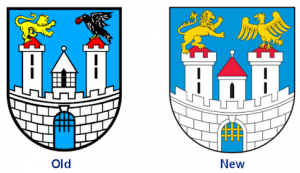 This year, the City of Częstochowa is celebrating the 800th anniversary of its written history. There will be academic conferences, film screenings, cultural events AND a new coat-of-arms.
This year, the City of Częstochowa is celebrating the 800th anniversary of its written history. There will be academic conferences, film screenings, cultural events AND a new coat-of-arms.
The crow, which was placed there in the early 1990’s out of respect for Jasna Góra, has disappeared. According to Gazeta Wyborcza, in heraldry, it is a symbol of Satan.
At a press conference held on Thursday 6th February, Częstochowa Mayor Krzysztof Matyjaszczyk promised that “there will be many surprises for locals” as part of the anniversary celebrations.
What is of particular interest to the World Society is that, included in this, will be an upgrade to the Stary Rynek (Old Market Square) which is due to be completed mid-2020. Prior to World War II, the Stary Rynek was a centre of Jewish communal and commercial activity.
Treblinka Through the Eyes of Samuel Willenberg z"l
Latest News
Words and pictures: Alon Goldman and the Institute of National Remembrance
In a ceremony held in Warsaw, on 29th January 2020, Ada Willenberg, the widow of our landsmann Samuel Willenberg z'”l, officially opened an exhibition of her husband’s bronze sculptures depicting his images of Treblinka. Samuel, who sadly passed away in February 2016, was the last living survivor of Treblinka and saw it as his mission to educate others about what happened there.
The Official Opening took place in the presence of a large audience and was attended by the Polish Deputy Minister of Culture and National Heritage, Jarosław Selin, and was one of the events marking the 75th anniversary of the liberation of the Auschwitz-Birkenau death camp.
The fifteen sculptures, which arrived in Warsaw from Tel Aviv, depict one of the most tragic episodes of the Holocaust through the most dramatic scenes of routine life in the extermination camp – the death factory which the Nazis established in Treblinka – as burned into Willenberg’s memory.
The exhibition will be on show for a year in Poland and, after its time in Warsaw, will travel to Białystok, Gdańsk, Kielce, Kraków, Lublin, Szczecin and to Willenberg’s home town Częstochowa.
In Warsaw, the exhibition will be open to the public at the “History Point” Education Centre at ul. Marszałkowsa 21/25 from January 29 until the end of March 2020. Viewing times are:
Mondays to Fridays: 8:00am – 8:00pm.
Saturdays: 9:00am – 2:00pm.
Closed on Sunday.
Visitors to the exhibition can also view the documentary film “The Last Witness of Treblinka” (100 mins.) by American television station WLRN, which tells the story of Samuel Willenberg .
Admission is free.
Groups are asked to coordinate arrival by telephoning: +48-22-576-3009
In Czestochowa, Samuel Willenberg’s hometown, the exibition will go on display in early October 2020, coinciding with the city’s Huberman Violin Festival.

